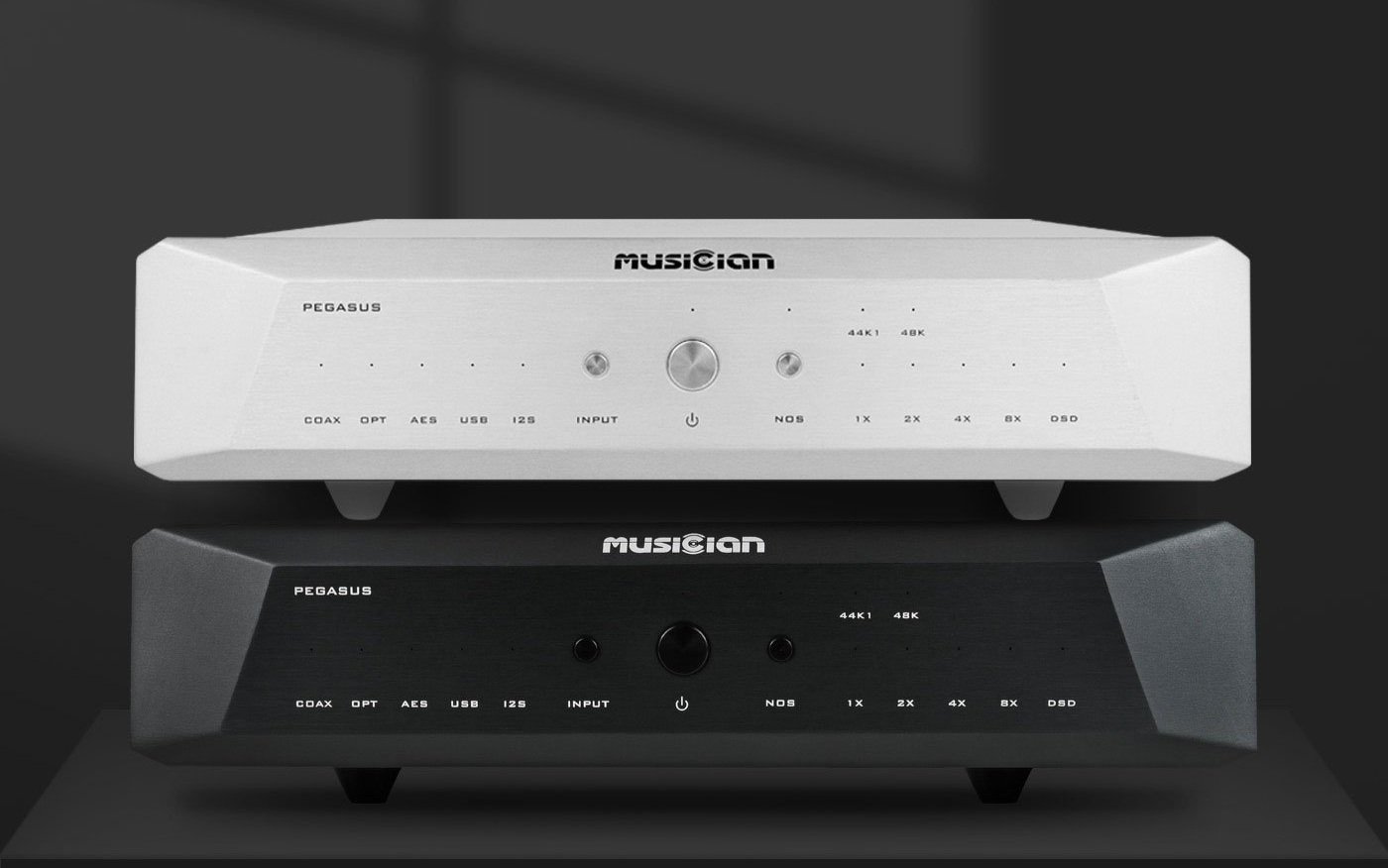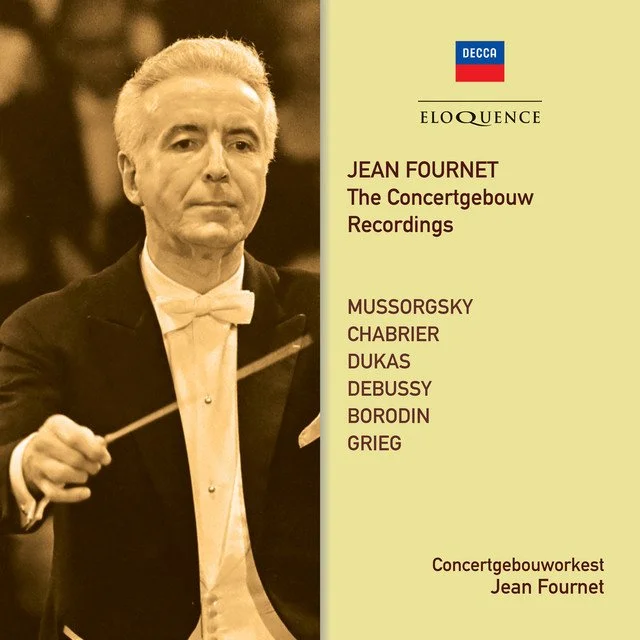MUSICIAN AUDIO PEGASUS - REVIEW
MUSICIAN AUDIO PEGASUS
Guanghou LEZHIJIA Technology Co., Limited, know as MUSICIAN Audio stateside, is a Chinese manufacturer of a bookshelf loudspeaker in addition to a range of analog and digital electronics. Their $1099 entry into the DAC competition is the PEGASUS, an 8.6 pound slab of aluminum with three blunt cone, elastomer–tipped feet and only three front panel buttons. A larger central button powers up the device with a long click, while the left flanking button selects input and the right switches conversion modes. More on that last one in a bit.
MUSICIAN Audio has the PEGASUS situated in the middle of their DAC line, with the $3,199 Aquarius at the top, and the $749 Draco taking up the rear. All three utilize an R-2R architecture. They also share a heavy duty construction and chunky aluminum casework, a very positive selling point for the product. The build quality is excellent, with PEGASUS having enough heft to stay in place even with those weighty audiophile interconnects and power cords we all love.
PEGASUS eschews the standard monolithic oversampling DAC “chip” or integrated circuit, widely employed by most manufacturers, in favor of an “R-2R” architecture made from individual parts. Don’t worry about the extremely high tweak factor, but basically R-2R refers to a particular "resistive ladder" design, a symmetrical ladder–like string of parallel and series–connected resistors acting as a binary decoder. As you may remember, binary arithmetic is the language of both computers and digital audio and, in the case of an R-2R ladder, each “rung” decodes one bit. A 24 rung ladder handles 24 bits. This seemingly simple design choice can, when realized with fancy, precision resistive elements, convert digital audio input signals into a representative analog output. As with everything where both digital and analog are concerned, the devil is in the details. Generally, an R-2R design trades off linearity for a lower noise floor. In the case of PEGASUS, they address linearity or distortion shortcomings with a digital corrective. We’re not talking some sort of GI tract tonic, this remedy consists of computer code executing on a special chip, an FPGA or Field–Programmable Gate Array. FPGAs are big ass chips that run reusable custom code fast and, in this case, allows MUSICIAN to reduce resistor value variations in software.
The PEGASUS offers five back panel choices for input, with all the usual suspects: USB plus AES3 on RCA (unbalanced), XLR-3 (balanced) and F05 (optical). A bit of a head scratcher, for me anyway, was the additional inclusion of I²S or “Inter-IC Sound,” which was originally designed as a very short distance, internal connection protocol between chips on the same circuit board‡. Proponents of external I²S inputs, including Wyred4Sound and Mola Mola, tout the benefit of separate clock and data lines, which reminds me of Sony’s old SDIF serial protocol used on their first professional digital audio products. As I could not secure any sources of “I2S”, which appears on the PEGASUS as an HDMI connector, I left that for a future review of one of MUSICIAN Audio’s protocol converters. Likewise, I discounted the AES inputs as USB is more likely to be used and far more difficult to implement well. Thus, an extra challenging test.
Almost all modern DAC chips use oversampling, a method of slicing time into integer multiples of the audio stream’s sample rate. So too does the PEGASUS, the difference being it’s realized in discrete circuitry with individual resistors and capacitors, whereas in most converters it’s built in at the miniature integrated circuit level. Oversampling makes the audio stream appear to have been recorded at a higher sample rate: 2, 4, 8 or higher times the original. Because there are more artificially created samples per second, the DAC has more “information” to work with per unit of time. Oversampling moves the upper output frequency limit, the Nyquist frequency, out of our range of hearing. This allows the reconstruction or anti–image filter to have an ultrasonic resonant frequency. This, in turn, means that in the range of frequencies we can hear, the amplitude and phase response are better behaved. Less ripple or amplitude variation combined with less temporal or phase distortion.
I have always considered oversampling in a DAC to be a bandaid obscuring poor filter design but, like most aspects of audio, it really comes down to taste. No high end DAC designs that I know of feature user–selectable oversampling, it is solely the domain of entry and mid–level products to either offer choice or, as I mentioned, to provide alternative voicing. In more costly designs, the engineering team voices the product, creating a filter that most closely expresses their idea of perfection. With all DACs, a large contributor to the overall sound is the crucial reconstruction filter. With discrete oversampling designs like MUSICIAN’s, that’s doubly true. In oversampling mode, you really are listening to their filter’s behavior above all else.
The PEGASUS front panel has a red LED to indicate non–oversampling, while in oversampling mode the LED is extinguished. Switching from non–oversampling mode to oversampling, the midrange recedes a bit while the soundstage shrinks slightly. Also in oversampling mode, the “detail” increases, while slam becomes less potent. I placed quotes around that adjective, as the apparent detail, at least in the PEGASUS implementation to my ears, was slightly off–putting and verging on harsh. Subjectively, it was as though some fairly aggressive lower treble boost had been applied. Though I’m all for equalization, and routinely use it to voice my speakers and headphones, I don’t want my hardware to have an EQ character baked in. Again, your milage may vary and, with a dark, single driver full range speaker or vintage hollow state amplification without an extended high end, then this option may be just what you’re looking for to bring some crispness into your world.
Okay, back to non–oversampling mode and listening… I started with Aimee Mann, one of my perpetual favorites for her writing and performance talents. Her 2012 Charmer release [44.1 Qobuz] is an artful collection of evocative compositions clothed in hooky frocks. The title track combines a sawtooth synth intro with straight up rock percussion and requisite guitar foundation. With PEGASUS magically turning numbers into actual music, the acoustic space around the drums, the keyboard, the particular guitar signatures and Mann’s distinctive lead are all rendered with their individuality intact.
Lazing through recent Qobuz curated selections, I paused for a time on Connie Han’s melodic 2022 jazz album, Secrets of Inanna, on Mack Avenue [96k Qobuz]. The opening track presents the band in a wholly convincing manner, with a humanly scaled piano and trap drum kit, accompanied by upright bass and countered with tasteful parallel flute lines. PEGASUS painted the scene with a mellow, smooth flowing brush. Also in a jazzy vein, up and comer Samara Joy’s 2022 album Linger Awhile on Verve [96k Qobuz] gave me a glimpse into sadness, disappointment and betrayal with Elisse Boyd’s lyrics of philandering spouses. Guess Who I Saw Today is a justifiably stripped down quintet production, spotlighting Joy’s rich and sonorous vocal style. The warmth of PEGASUS’ voicing nicely complemented the relaxed, trad stylings of Joy and her backing musicians. Watch for great things to come from this artist.
Given the right material, PEGASUS takes wing, soaring aloft with hoofs pawing the air and glinting in the sun. As an example; a “lowly” Red Book (44.1Khz) recording of the Royal Concertgebouw Orchestra’s 2018 release of Dukas’ L’Apprenti sorcier on Decca Eloquence [Jean Fournet – The Concertgebouw Recordings, 44.1 Qobuz]. This prehistoric recording, dating from 1959, is a big, bold document with a soundstage to match. Even at a baseband sample rate, the percussion has sparkle, the brass is properly brash, and the strings lush not strident. Compare that to a 2022 release, Alpha Classics’ Handel: Coronation Anthems [96k Qobuz]. I was amused and delighted by the 2021 performance and Hervé Niquet’s direction but disappointed by the production, which conveyed an image of a miniature orchestra and chorus of Barbie–sized singers playing from afar. I’m not familiar with the venue, the Philharmonie de Paris but, through the MUSICIAN Audio converter, the wet, distant rendition was in startling and sad contrast to the fifty year old recording, even at less than half the sample rate!
I wanted to offer not only a different genre as example but also one that benefited from oversampling. Take last month’s release of Three Sides of One [96k Qobuz], a lively and melodic prog metal romp from the Show Me state’s King’s X. Surprisingly for an all–analog production, the result is not what I’d call high fidelity but it sure does rock! Though mastered by Scott Sedillo at Bernie Grundman Mastering, it lacks a well defined top end. Recording engineer Michael Parnin did go for a squishy, retro-’70s sound, and the hooded lack of clarity called to me for a bit more…bite. This is, after all, by its very nature supposed to be a pugnacious piece, so I pushed the magic button for oversampling and was rewarded with the extra sizzle I was hoping for. So there, I laugh at my own audiophile smugness!
Once I had a handle on the sound of the PEGASUS, I thought it would be sensible to conduct some comparisons. At half the price, the AKM version of Geshelli’s groovy little peekaboo JNOG2 DAC (AK4493 for all you tweakophiles), was an instructive listen… I found the fundamental takeaways to be a slightly narrower but deeper soundstage with better focus of transients. This was in keeping with AKM’s design choice that retains low amplitude linearity. The JNOG2 AKM edition lent a pleasant increase in crispness, though far from the macho version that the PEGASUS provides in oversampling mode. At the bottom end of things, the JNOG2 exhibited a tighter low end with less slam than the winged PEGASUS. My guess is that PEGASUS’ more beefy power supply is responsible for the heightened grunt factor. On the other hand, how would the PEGASUS hold up against my reference DAC at about double the price? The exaSound e22 Mk. II has only USB and AES3 ins, with balanced and unbalanced outs, but still it wasn’t a fair fight. The e22 lifted a scrim obscuring inner low amplitude detail, while expanding the soundstage dramatically. By the way, for all these examinations I used balanced outs directly from the DAC under test to my JC 5 power amp.
The $1-2k market segment for DACs is a crowded one with some very capable contenders, so I would definitely listen rather than reading before landing on a final purchase. That said, the PEGASUS represents a solid investment in mellow digital audio conversion. The overall careful construction, effortless ease of use, plethora of input choices and ability to upgrade the performance via I²S all make for a compelling package.
PEGASUS R–2R DAC $1099
Baiyun District, Guangzhou City
Guangdong CN
+86 20-39293669
https://www.musician-audio.com/
US Representative:
Audio Art Cable
San Diego CA
+1 619-417-3035
https://www.audioartcable.com/






